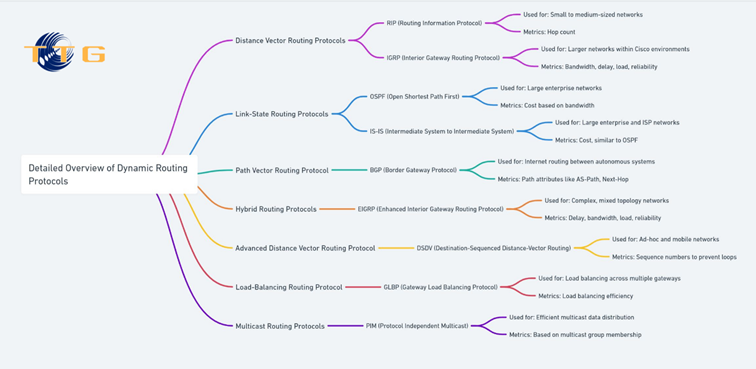In the intricate world of modern networking, dynamic routing protocols stand as the backbone for efficient data transmission. These protocols, unlike their static counterparts, offer the flexibility and efficiency needed to adapt to ever-changing network conditions. Let’s delve into the seven key types of dynamic routing protocols, exploring their uses, metrics, and significance from a network management perspective.

Figure 1. Types of Routing Protocols
Distance Vector Routing Protocols
RIP (Routing Information Protocol)
- Use Case: Ideal for small to medium-sized networks.
- Metric: Primarily uses hop count.
- Network Management Perspective: RIP is simple and easy to configure, making it a good choice for smaller networks without the need for complex routing.
IGRP (Interior Gateway Routing Protocol)
- Use Case: Developed by Cisco, it’s tailored for larger networks within Cisco environments.
- Metrics: Utilizes bandwidth, delay, load, and reliability.
- Network Management Perspective: Offers better scalability and control compared to RIP, suitable for larger, more diverse networks.
Link-State Routing Protocols
OSPF (Open Shortest Path First)
- Use Case: Commonly used in large enterprise networks.
- Metric: Cost based on bandwidth.
- Network Management Perspective: OSPF is efficient in managing network traffic by calculating the best route using the state of each network link.
IS-IS (Intermediate System to Intermediate System)
- Use Case: Often employed in large enterprise and service provider networks.
- Metric: Cost, similar to OSPF.
- Network Management Perspective: IS-IS is robust and scalable, making it suitable for complex network infrastructures.
Path Vector Routing Protocol
BGP (Border Gateway Protocol)
- Use Case: The core protocol for internet routing between autonomous systems.
- Metrics: Path attributes like AS-Path, Next-Hop.
- Network Management Perspective: BGP is crucial for maintaining a stable and efficient internet, managing how packets are routed through various networks.
Hybrid Routing Protocols
EIGRP (Enhanced Interior Gateway Routing Protocol)
- Use Case: Ideal for complex, mixed topology networks.
- Metrics: Delay, bandwidth, load, reliability.
- Network Management Perspective: EIGRP offers the benefits of both distance vector and link-state protocols, providing versatility and efficiency.
Advanced Distance Vector Routing Protocol
DSDV (Destination-Sequenced Distance-Vector Routing)
- Use Case: Primarily used in ad-hoc and mobile networks.
- Metric: Sequence numbers to prevent loops.
- Network Management Perspective: DSDV is suitable for dynamic and changing network environments like mobile networks.
Load-Balancing Routing Protocol
GLBP (Gateway Load Balancing Protocol)
- Use Case: Enables automatic selection and load balancing between multiple gateways.
- Metric: Load balancing efficiency.
- Network Management Perspective: GLBP is essential for optimizing resource utilization and enhancing network performance.
Multicast Routing Protocols
PIM (Protocol Independent Multicast)
- Use Case: Efficient distribution of multicast data over a network.
- Metrics: Based on multicast group membership.
- Network Management Perspective: PIM is vital for scenarios requiring efficient data distribution to multiple destinations.
Each of these dynamic routing protocols brings unique characteristics to the table, making them suited for specific network environments and requirements. Their role in ensuring data is routed efficiently, reliably, and quickly across complex and ever-changing network topologies cannot be overstated. As network demands continue to evolve, these protocols will remain integral in shaping the future of network management.



